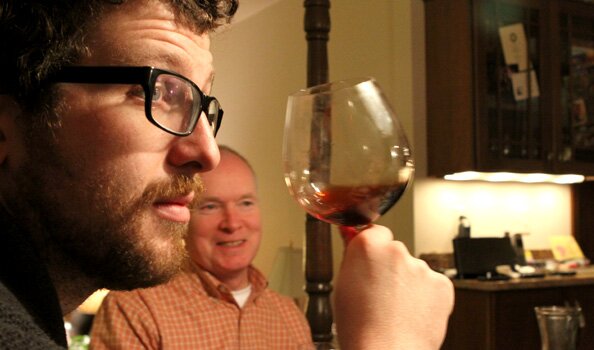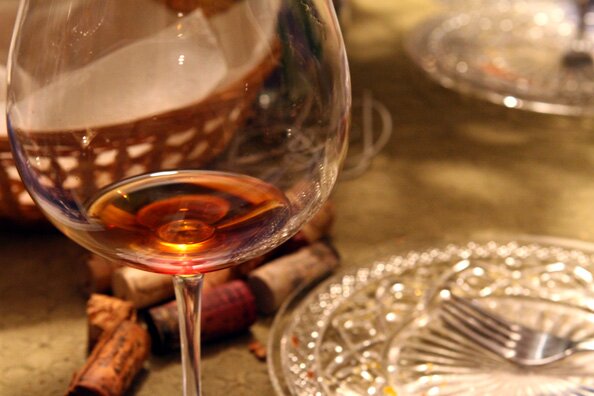Our sincere apologies, but no results were found for the requested archive. Todd probably had one too many Manhattans and ate the post you were looking for.

Tag Archives: vintage wine
NOT FOUND
Neither Rain, Nor Snow, Nor Sleet: Wine Lovers Shall Not Be Deterred
Wine can make people do crazy things: spend too much money, consume too much alcohol, or in the case of me and some friends, drive 35 miles in a blizzard that ultimately produced 10+ inches of snow. Of course, these weren’t just any wines. Nine-dollar bottles of Grenache aren’t worth spin outs and 90-minute car rides.
No, these were older wines.

Properly stored, old wine offers a unique and wonderful experience. And while writing about that wonderful experience on a blog is inherently self-indulgent – outright braggotry, really – it’s also a chance to explore one of those aspects of wine that can be intimidating and seem out of reach. Perhaps more importantly, it’s an opportunity to provide some much-needed context for the mythos and aura of inscrutability that seems to surround cellared wines.
Among all the supermarket wines that have immense popularity among broad audiences and among many of the lighter, so-called natural wines that have justifiably obtained a cult-like status with many aficionados, one thing that’s often missing is the potential for aging – that is, an intense structure of tightly coiled flavors that can unfurl into unparalleled elegance over time.
So when our good friends Steve and Robin invited a number of us over to open some cellared bottles (mostly Steve’s), neither snow, nor rain, nor gloom of night could have deterred us from that enjoyment.

The line up, in the order we tasted them:
1999 Drouhin – Volnay, 1er Cru, Clos des Chenes
You know that your day is off to a good start when you’ve “warmed up” on Farnum Hill hard cider and your first act is a burgundy with ten years of age on it. Notably floral on the nose with some hints of berry. Nicely structured with surprising tannin for such a lightly colored wine.
1985 Breton – Bourgeil, Les Perrieres
While not the most electrifying wine of the night, this cabernet franc from the Loire Valley proves to be quite illustrative of the concept of what happens to nicely structured, well made wine as it ages. Many younger bottles of this wine are delicious but are so heavy with astringency from tannins and with flavors of tar that it can be a chore for newcomers to cab franc to enjoy it. Over time, though, this wine hasn’t lost any of its oomph, but the tannins have relaxed a bit. There’s a spicy, poignant quality to the finish and a lot of very bright fruit flavors up front. This would have tasted much different in 1988 than it does today. I’d guess it would have been more like a knife on the palate – hard and sharp – than so broad and flavorful. Delicious either way but truly elegant later in life.

1986 Chateau Talbot – St. Julien
Great Lakes roastmaster James Cadariu and his finely honed olfactory senses immediately noticed that “this wine smells like poop. But,” as he went on to explain, “in a good way.” It definitely begins with a very dirty, very barnyard, very fecal nose. Brettanomyces, perhaps? In terms of flavor, however, any hint of that flaw is gone. Instead, it’s elegant and layered with chocolatey black fruit and smoke. Nicely balanced with acidity. There’s still some tannic structure, but a lot of it has faded to let that delicate fruit flavor through.
2001 Voge – Cornas, Vielles Vignes
Pours with just the slightest purple hue, and the aromatics are quite expressive. Berries and flowers hint at what’s to come: While there’s still plenty of tannin and some pepper, it’s fundamentally a feminine and pretty wine.
1988 Fattoria dei Barbi – Brunello di Montalcino
Wines can sit too long, of course. While they can develop complexity, the various reactions taking place inside the bottle can also free up sugars or create off flavors or aromas. I’m not precisely sure what happened to this Brunello, but it tasted like brown sugar and had a very syrupy mouthfeel despite its age. It had a funny, herbal nose, and while it was drinkable, the only descriptor I can come up with is “strange.” This certainly illustrates two of the common myths with cellaring wine – that any red wine will get better with age and that wines can age indefinitely. It’s a living thing that evolves in the bottle. The number of years of age matter, but so does the original juice put into the bottle, itself a product of climate, technique, and the blend of grapes. Wines have a peak, and this wine was looking at its peak in the rear view mirror.
1970 Cappellano – Barolo, Serralunga d’Alba
I might be biased since I brought this to the party, but this was one of my favorite wines of the night. Aromatically complex, this wasn’t nearly so fecal as the 86 Ch. Talbot, but it definitely carried a funk to it that smelled to me like decomposing grass clippings and some funky cheese. That lessened as the wine opened up, but some element of that aroma was always there. On the palate, though, it was remarkably bright with some pleasant acid and lots of tannic structure left. While it was bone dry, there was still enough fruit to keep it in balance. A very elegant but powerful, masculine set of flavors. Surprisingly, while this was expectedly light and transparent, it was also very much reddish in color. Older red wines tend to develop a brick-ish brown color over time.
1995 Vieux de Telegraphe – La Crau, Chateauneuf de Pape
Another standout in an evening full of them. This is arguably the most pleasing wine of the night aromatically speaking, still showing quite a bit of fruit and pleasant herbal qualities in the nose – fresh coffee, pepper, and just a bit of funk compared to some of the much older wines from earlier. Very spicy and fruity on the palate. These wines can be delicious but very closed down early, but this is at its peak, so to speak, just full of flavor that lingers and surprisingly, almost light on the tongue. This is what happens when top flight producers with good grapes make wine that doesn’t force wine media-approved blackberry flavor down your throat.
1997 Luciano Sandrone – Barolo, Cannubi Boschis
While this event wasn’t really planned to be an illustration in the various aspects of older wines, nor a showdown between classic winemaking and modern winemaking, it has certainly turned out that way. This Barolo is from a storied property, but you’d never know it was Barolo. While it’s not poorly made, it only tastes like berries and oak (more specifically, it tastes like vanilla and lotion). It may shed some of the obvious vanilla flavor over time, but this will never show that kind of elegance we saw in earlier wines.
1976 JJ Christoffel – Urziger Wurzgarten, Trockenberenauslese
In contrast to red wines, which get lighter as sediment falls out of the wine, whites get browner and darker as they age. And instead of tannins helping to preserve the wine and breaking down to provide flavor, the high sugar and acid content in Rieslings like this tend to be the preservative element that lets them age so well. And this is a perfect illustration of both: It pours a dark brown, caramel color, a stark contrast to the highlighter yellow of a younger wine, and it is holding up very well. Tastes like toffee and tart mixed fruit jam. Very sweet but still in balance and drinkable. This isn’t a dessert wine; it’s dessert, period.
* * * * *
Wines made for keeping aren’t inherently better than other bottles, but they’re unquestionably different. Tasting notes, no matter how descriptive, can’t really convey the nuance and elegance of properly stored, cellared wines. And a single blogger living on the outskirts of Detroit with a modest history with aged wine can’t possibly do them justice.
But hopefully, he can convince you they’re worth seeking out.

Without a cool, dark space with relatively consistent temperature in which to store wines for 5, 10, 20 years – or more importantly, without the patience to wait that long – the only way to try old wines is to buy them from a trusted retailer that specializes in holding on to bottles, buying other people’s cellars, or buying up library releases (i.e., when a winery sells older stock that it has kept at the winery for aging).
Locally, our choices are limited. I’m sure that there are other stores of which I’m not aware, but a Detroiter’s best bet is to stop in and see Elie in Royal Oak or perhaps to ask another retailer to special order something if you have knowledge of a library release coming to town. I know that both Western Market in Ferndale and Cloverleaf in Royal Oak have purchased one or two older vintages of Rieslings in years past.
Alternatively, hit the Internet. Places like Cellar Raiders and Chambers Street Wine have a good track record of finding properly stored wines and selling them off. A good retailer will probably offer suggestions or tasting notes – Chambers often does – but if one is uncertain as to a particular vintage or producer, an hour or so of poking around Google will reveal a lot of the information one could need to get started.
Cost becomes a factor for buying cellared wines or library releases, of course. But these aren’t daily drinkers, and the way I’ve hurdled the expense barrier is to (a) only buy a tiny number of these per year, (b) do research, wait patiently, and buy very selectively, and (c) start a tiny side business that gives me a little leeway to blow on a $100 or $125 bottle. Any or all of these are a good way to avoid timidly asking your local bank for a wine mortgage.
Finally, if you’re really desperate to try some older wines and don’t have a penny to your name, you could always come to the next Gourmet Underground Detroit event, hope Steve shows up, and suck up to him. He likes good food, wine, and scotch. And he accepts gifts.
Search
Popular Tags
ann arbor beer Bordeaux bourbon brandy California Chartreuse cocktails coffee fermentation food France gamay gin Inside Detroit italy kombucha liquor local Loire maraschino media Michigan Muscadet nature pinot noir punch recipe restaurants Rhone rum rye sauvignon blanc Savoie sherry soda Spain tasting tea travel Uncategorized vermouth whiskey whisky wine
Friends & Members
Drinks
- Cork Wine Pub
- Detroit Drinks
- Fermentation Nation
- Gang of Pour
- Girly Drinks
- Great Lakes Coffee Roasting Co
- MotorCity Wine
- ouvert 7 jours
- The Sugar House Bar
- Total Kombucha
- Beau Bien Fine Foods
- Corridor Sausage Co.
- Detroit Spice Company
- Detroit Zymology Guild
- Neighborhood Noodle
- Porktown Sausage
- simmer down! (a food lover's blog)
- Simply Suzanne Granola
- The Savage Feast
- House of Raw
- Marvin Shaouni Photoblog
- Metro Times
- Model D
- Natural Detroit
- Perfect Laughter
- Remains of the D
- The Night Train
Archives
July 2012
June 2012
May 2012
April 2012
March 2012
February 2012
January 2012
December 2011
November 2011
October 2011
September 2011
August 2011
July 2011
June 2011
May 2011
April 2011
March 2011
February 2011
January 2011
December 2010
November 2010
October 2010
September 2010
August 2010
July 2010
June 2010
May 2010
April 2010
March 2010
February 2010
January 2010
December 2009
November 2009
October 2009
May 2009
November 2008
October 2008
July 2008
April 2008
March 2008
February 2008
January 2008